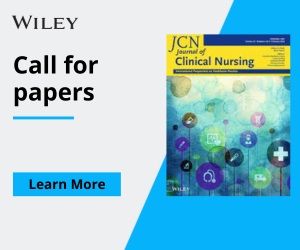Stop Pressure Ulcer Day 2016
Stop Pressure Ulcer Day 2016Stop Pressure Ulcer Day is marked all over the world, and involves health professionals, the media, industry and others working together to increase public knowledge and awareness of this significant (and largely preventable) form of harm.
Stop Pressure Ulcer day is a day to focus on increasing knowledge and awareness of pressure damage. As health professionals, we are cognisant of the harms caused by pressure injuries and the enormous personal and economic costs they represent. In the wider community, rather less is known and understood about this form of harm, and the devastation it can wreak on individuals.
Here at the Journal of Clinical Nursing, we have a major commitment both to increasing health literacy and to eliminating all forms of patient harm, and this includes pressure injury. To mark Stop Pressure Ulcer Day 2016 we are proud to provide free access to a selection of articles on pressure injury. We hope these will be widely circulated and read.
Chaboyer, W. and Gillespie, B. M. (2014), Understanding nurses' views on a pressure ulcer prevention care bundle: a first step towards successful implementation. Journal of Clinical Nursing, 23: 3415–3423. doi: 10.1111/jocn.12587
Hommel A, Gunningberg L, Idvall E. & Bath C. (2016). Successful factors to prevent pressure ulcers: An interview study, Journal of Clinical Nursing.
Lannering, C., Ernsth Bravell, M., Midlöv, P., Östgren, C.-J. and Mölstad, S. (2016), Factors related to falls, weight-loss and pressure ulcers – more insight in risk assessment among nursing home residents. Journal of Clinical Nursing, 25: 940–950. doi: 10.1111/jocn.13154
Li, D. (2016), The relationship among pressure ulcer risk factors, incidence and nursing documentation in hospital-acquired pressure ulcer patients in intensive care units. Journal of Clinical Nursing, 25: 2336–2347. doi: 10.1111/jocn.13363
Meesterberends, E., Wilborn, D., Lohrmann, C., Schols, J. M. and Halfens, R. J. (2014), Knowledge and use of pressure ulcer preventive measures in nursing homes: a comparison of Dutch and German nursing staff. Journal of Clinical Nursing, 23: 1948–1958. doi: 10.1111/jocn.12352
Moore, Z. and Cowman, S. (2012), Pressure ulcer prevalence and prevention practices in care of the older person in the Republic of Ireland. Journal of Clinical Nursing, 21: 362–371. doi: 10.1111/j.1365-2702.2011.03749.x
Rodrigues, A. M., Ferreira, P. L. and Ferré-Grau, C. (2016),Providing informal home care for pressure ulcer patients: how it affects carers' quality of life and burden. Journal of Clinical Nursing, 25: 3026–3035. doi: 10.1111/jocn.13356
Romero-Collado, A., Homs-Romero, E. and Zabaleta-del-Olmo, E. (2013), Knowledge about medications and products to prevent and treat pressure ulcers: a cross-sectional survey of nurses and physicians in a Primary Health Care setting. Journal of Clinical Nursing, 22: 2562–2571. doi: 10.1111/jocn.12175
Sardo, P., Simões, C., Alvarelhão, J., Costa, C., Simões, C. J., Figueira, J., Simões, J. L., Amado, F., Amaro, A. and Melo, E. (2015), Pressure ulcer risk assessment: retrospective analysis of Braden Scale scores in Portuguese hospitalised adult patients. Journal of Clinical Nursing, 24: 3165–3176. doi: 10.1111/jocn.12927
Skogestad IJ, Martinsen L, Børsting TE, Granheim TI, Sigurdssøn Ludvigsen E, Gay CL. & Lerdal A. (2016). Supplementing the Braden scale for pressure ulcer risk among medical inpatients: the contribution of self-reported symptoms and standard laboratory tests, Journal of Clinical Nursing.
Skytt, B., Engström, M., Mårtensson, G. and Mamhidir, A.-G. (2016), A longitudinal qualitative study of health care personnel's perceptions of simultaneous implementation of three risk assessment scales on falls, malnutrition and pressure ulcers. Journal of Clinical Nursing, 25: 1912–1922. doi: 10.1111/jocn.13207
Theisen, S., Drabik, A. and Stock, S. (2012), Pressure ulcers in older hospitalised patients and its impact on length of stay: a retrospective observational study. Journal of Clinical Nursing, 21: 380–387. doi: 10.1111/j.1365-2702.2011.03915.x






